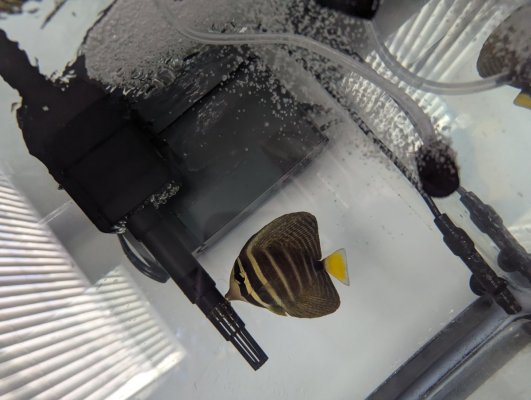So I have a 180G system approaching a year old and unfortunately (and covered here before) I chose to add fish without quarantine and had an outbreak of either velvet or brook that wiped out more than half of my fish. The survivors were a foxface, azure damsel and 2 cardinals. Since then, with QT tanks I had successfully added a 2 clowns, a white tail tang, melanurus wrasse, sailfin tang and lastly 3 square back anthias, all was starting to look quite good and I was pretty well happy with a moderate stocking level for now. Then last week the male anthias which had always been acting peculiar compared to the others became listless other than during feeding and over the course of a few days basically died, no signs of anything external other than color fading on the last day or so. Almost immediately the white tail got spots, starting shedding slime coat and stopped eating, died, followed by the other 2 anthias just seeing to give up and die, the sailfin broke out in spots and I was sure I would lose him.
Now my tank has extensive cave systems in the rocks and some established corals and anemones, catching all of the fish seems impossible without a complete tear down, I managed to catch the clowns and they are in a QT tank with copper, I was unable to catch anything else and I am worried about stressing them all further by chasing them around. I treated the main tank with prazipro and nothing else has died. The sailfin, remarkably, is improving with fewer spots and all remaining fish are eating well. The clowns seem fine in QT.
So of the fish I added since the last outbreak, everything but the wrasse and the clowns have either died or been infected with something that looks like velvet in the last 2 weeks. Is it possible that velvet is in the tank but that the fish that survived last time and the tougher fish that I bought since are somehow able to live with it? Strangely the clowns and sailfin that are doing OK came from petco, the anthias and white-tail (all dead) came from a well regarded LFS.
I have ICP tests from before and after the outbreak but other than increasing iodine levels (for my corals and inverts), nothing was changing much and everything is quite well in range.
It feels like I have 2 choices :
1) strip the whole thing down, put all the fish in QT and do a fallow period for the tank (would this have to include the nem's?)
2) continue to add QT'd fishes again with the expectation that some will not make it when introduced to the main tank.
maybe an option to use water from the main tank after QT to introduce individual fish to the "infected" system before they go in and cause an outbreak?
Any thoughts, opinions, advice?
Thanks
Now my tank has extensive cave systems in the rocks and some established corals and anemones, catching all of the fish seems impossible without a complete tear down, I managed to catch the clowns and they are in a QT tank with copper, I was unable to catch anything else and I am worried about stressing them all further by chasing them around. I treated the main tank with prazipro and nothing else has died. The sailfin, remarkably, is improving with fewer spots and all remaining fish are eating well. The clowns seem fine in QT.
So of the fish I added since the last outbreak, everything but the wrasse and the clowns have either died or been infected with something that looks like velvet in the last 2 weeks. Is it possible that velvet is in the tank but that the fish that survived last time and the tougher fish that I bought since are somehow able to live with it? Strangely the clowns and sailfin that are doing OK came from petco, the anthias and white-tail (all dead) came from a well regarded LFS.
I have ICP tests from before and after the outbreak but other than increasing iodine levels (for my corals and inverts), nothing was changing much and everything is quite well in range.
It feels like I have 2 choices :
1) strip the whole thing down, put all the fish in QT and do a fallow period for the tank (would this have to include the nem's?)
2) continue to add QT'd fishes again with the expectation that some will not make it when introduced to the main tank.
maybe an option to use water from the main tank after QT to introduce individual fish to the "infected" system before they go in and cause an outbreak?
Any thoughts, opinions, advice?
Thanks




















